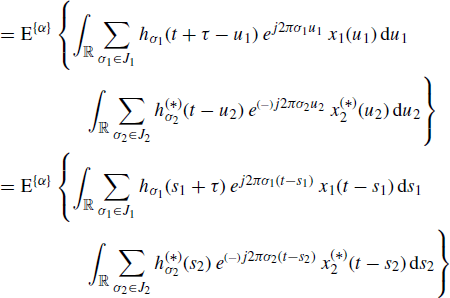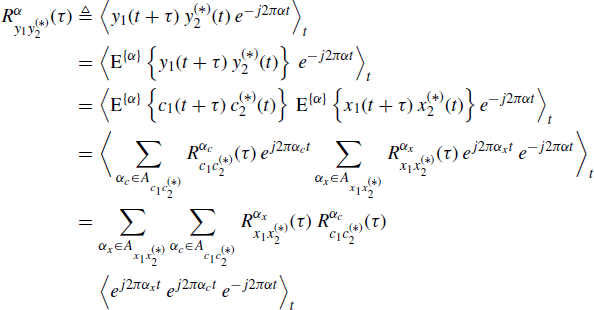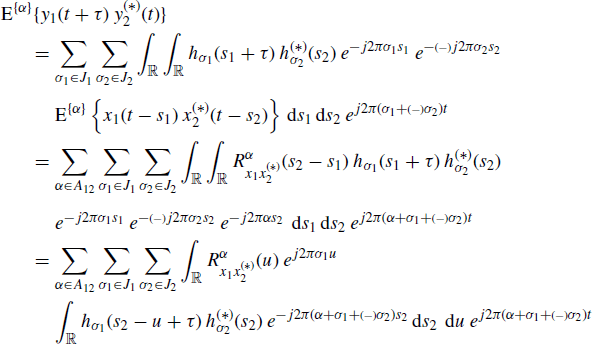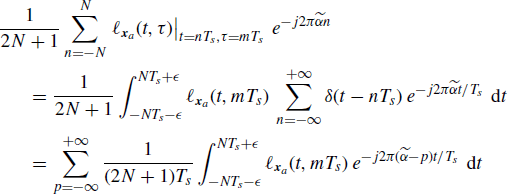6.5 Proofs of FOT Counterparts of Some Results on ACS and GACS Signals
In this section, proofs of some results presented in Section 1.3 in the stochastic approach are carried out in the functional approach. Moreover, when possible, results are derived in the more general case of GACS signals.
6.5.1 Proof of FOT Counterpart of (1.114)
By substituting (1.112) into (1.113) we have

(6.79) 
where, in the last equality, the variable changes s1 = t − u1 and s2 = t − u2 are made. Thus by assuming that the order of sum, integral, and almost-periodic component extraction operations can be interchanged, and observing that almost-periodic functions can be led outside the almost-periodic component extraction operator, we get
where, in the last equality, the variable change s2 − s1 = u is made and, according to (1.95) (with the replacements ![]() and
and ![]() ), we put
), we put
(6.81) ![]()
By substituting (1.115) into (6.80), we get the FOT counterpart of (1.114) which is formally the same as (1.114).
6.5.2 Proof of FOT Counterpart of (1.116)
By taking the Fourier coefficient at frequency β of the almost periodic-function in the FOT counterpart of (1.114), we have
(6.82) 
Since
(6.83) ![]()
the FOT counterpart of (1.116), which is formally identical to (1.116), easily follows.
6.5.3 Proof of FOT Counterparts of (1.135) and (1.136)
By using the FOT counterparts of (1.131) and (1.132), which are formally identical to (1.131) and (1.132), we get
(6.84) 
from which the FOT counterpart of (1.135), formally identical to (1.135), follows observing that
(6.85) ![]()
The FOT counterpart of (1.136) easily follows by Fourier transforming both sides of the FOT counterpart of (1.135).
6.5.4 Proof of the FOT Counterpart of (1.173) for GACS Signals
Let ![]() ,
, ![]() , be the discrete-time signal obtained by uniformly sampling the complex-valued continuous-time signal xa(t) with sampling period Ts = 1/fs. The FOT counterpart of (1.173) is
, be the discrete-time signal obtained by uniformly sampling the complex-valued continuous-time signal xa(t) with sampling period Ts = 1/fs. The FOT counterpart of (1.173) is
where E{α}{ · } is the continuous-time almost-periodic component extraction operator (see (6.22)) and ![]() is the discrete-time almost-periodic component extraction operator which is defined similarly to its continuous-time counterpart.
is the discrete-time almost-periodic component extraction operator which is defined similarly to its continuous-time counterpart.
Proof: The second-order lag product ![]() can be decomposed into the sum of its almost-periodic component and a residual term
can be decomposed into the sum of its almost-periodic component and a residual term ![]() not containing any finite-strength additive sinewave component (Section 6.3.3). For a GACS signal, the result is that
not containing any finite-strength additive sinewave component (Section 6.3.3). For a GACS signal, the result is that
(6.87) 
where ![]() ,
, ![]() , and
, and
For any 0 < ![]() < Ts we formally have
< Ts we formally have
where, in the second equality, the Poisson sum formula
(6.90) ![]()
is accounted for. Taking the limit for N→ ∞ in (6.89) and accounting for (6.88) one has
That is, if the continuous-time residual term ![]() does not contain any (continuous-time) finite-strength additive sinewave component (see (6.88)), then also the sampled residual term
does not contain any (continuous-time) finite-strength additive sinewave component (see (6.88)), then also the sampled residual term ![]() does not contain any discrete-time finite-strength additive sinewave component.
does not contain any discrete-time finite-strength additive sinewave component.
Thus,
where in the third equality (6.91) is accounted for and in the last equality the fact that the right-hand side of (6.92) is a discrete-time almost periodic function is exploited.
Equation (6.86) is then proved observing that the right-hand side of (6.92) is coincident with the right-hand side of (6.86).
Note that, as in the stochastic approach, uniformly sampling a continuous-time GACS signal leads to a discrete-time ACS signal (Theorem 2.5.2).



